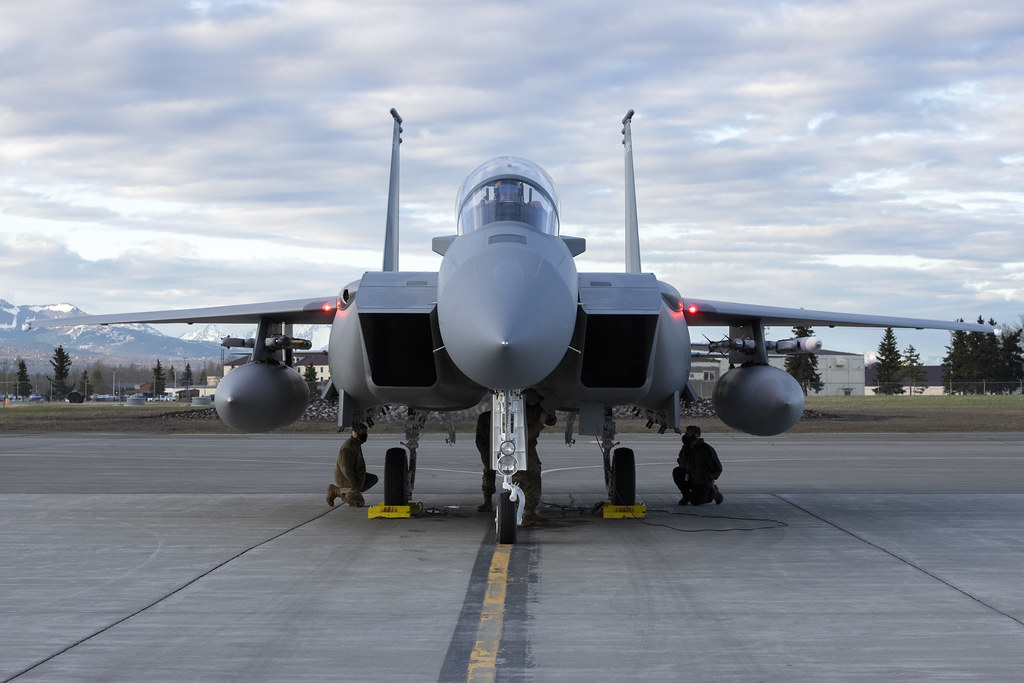
The U.S. Air Force’s latest F-15EX Eagle II, a modern adaptation of the classic F-15 platform, has raised eyebrows with its non-stealth profile in an era dominated by stealth-focused designs.

Despite this, the advanced fighter jet has solidified its place in the Air Force’s fleet, with capabilities that challenge conventional expectations of air superiority.

Boasting speeds up to Mach 2.25, the Eagle II is noted for its impressive armaments and avionics, such as the enhanced pulse-Doppler radar system and an extensive payload capacity of 13.6 tons, surpassing its predecessors and exemplifying its role as a versatile “bomb truck” of the skies.

This fighter is equipped to carry an array of weapons, including the AIM-9 Sidewinder and the AIM-120 advanced medium-range air-to-air missiles, as well as air-to-ground munitions ranging from cruise missiles to smart bombs.

The F-15EX’s inclusion of the Eagle Passive Active Warning Survivability System (EPAWSS) and digital fly-by-wire controls solidifies its capability to remain a formidable force against adversaries.

“Things started to melt around Mach 2 in the aircraft I flew,” the Strike Eagle pilot recounted. “The airframe and powerplant are more than capable [of reaching Mach 2.5-plus]. Paint and antennas, etc. are another story.”

With the ability to launch weapons from a high-speed platform, the jet is not only a critical asset in traditional combat but also holds the potential to carry outsize weapons, including hypersonic missiles.

Despite some experts considering the lack of stealth a “flaw,” the Eagle II has been designed with specific roles in mind where stealth is not a prerequisite.

The aircraft is envisaged to perform airbase and homeland defense, enforce no-fly zones, and deploy standoff weapons in support of frontline stealth fighters.

The strategy underlying the procurement of the F-15EX is rooted in its complementary role alongside stealthier jets like the F-22 and F-35, ensuring a robust air superiority capability for the USAF.

The first F-15EX was delivered to Eglin Air Force Base on March 11, 2021, with subsequent deliveries planned, highlighting a swift production and integration process.

The new Eagle variant is a direct descendant of the F-15QA developed for Qatar, incorporating advancements from the outset and promising a longer service life with reduced operating costs.

With its multirole strike capabilities, the F-15EX not only stands as a testament to the longevity of the F-15 series but also heralds a new chapter in the evolution of air combat.

In the face of modern air defenses, the F-15EX may not have stealth, but its arsenal, electronic warfare systems, and proven combat record position it as a critical asset in any potential large-scale conflict.

The Air Force’s investment in a fighter that challenges the traditional paradigm of stealth speaks to a strategic diversification of capabilities, ensuring that the United States maintains a dynamic and formidable presence in the skies.
Relevant articles:
– The F-15EX Eagle II Fighter Has One Big Question to Answer, The National Interest
– F-15EX Eagle II Archives, airandspaceforces.com
– The F-15EX Eagle II Fighter Has One ‘Flaw’ That Can’t Ever Be Fixed, The National Interest
– Just How Fast Is The F-15EX Really?, The War Zone

